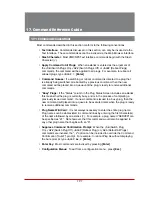
15-1
15. Saving and Restoring Configuration Parameters
Once the VMR/NPS is properly configured, parameters can be downloaded and
saved as an ASCII text file. Later, if the configuration is accidentally altered, the saved
parameters can be uploaded to automatically reconfigure the unit without the need to
manually assign each parameter.
Saved parameters can also be uploaded to other identical VMR/NPS units, allowing
rapid set-up when several identical units will be configured with the same parameters.
The "Save Parameters" procedure can be performed from any terminal emulation
program (e.g., TeraTerm
©
, etc.,) that allows downloading of ASCII files.
Note:
Configuration parameters can be downloaded and saved via either the
Web Browser Interface or Text Interface. Saved configuration parameters can
only be uploaded to the unit via the Text Interface.
15.1. Sending Parameters to a File
15.1.1. Downloading & Saving Parameters via Text Interface
1. Start your terminal emulation program and access the Text Interface command
mode using an account that permits Administrator level commands.
2. When the command prompt appears, type
/U
and press
[Enter]
. The VMR/NPS
will prompt you to configure your terminal emulation program to receive an ASCII
download.
a) Set your terminal emulation program to receive an ASCII download, and the
specify a name for a file that will receive the saved parameters
(e.g. VMR.PAR).
b) Disable the Line Wrap function for your terminal emulation program. This will
prevent command lines from being broken in two during transmission.
3. When the terminal emulation program is ready to receive the file, return to the
VMR/NPS’s Save Parameter File menu, and press
[Enter]
to proceed. VMR/NPS
parameters will be saved on your hard drive in the file specified in Step 2 above.
4. The VMR/NPS will send a series of ASCII command lines which specify currently
selected parameters. When the download is complete, press
[Enter]
to return to
the command prompt.






























